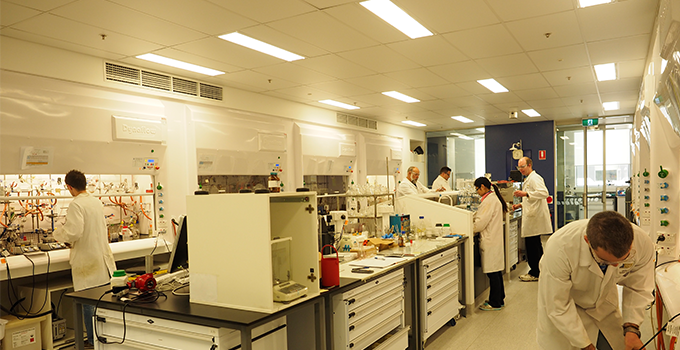The photonic age requires new materials

Materials with nonlinear optical (NLO) properties are becoming increasingly important in an age of photonics. With the capacity to modify the phase, frequency, amplitude, polarisation, intensity, and/or path of incident light, NLO materials have huge potential in technologies that involve the manipulation of light — whether it be optical signal processing, data storage, communication or image processing.
Through developing organometallic materials Professor Mark Humphrey, who was the recipient of two Australian Research Council (ARC) grants in late 2016, is trying to make the development of photonics much easier. Humphrey explains his work is based on a massive shift in technological development.
“We are heading from a civilisation that for the last 100 years has relied on electronics, so the movement of electrons, to one that is heading towards photonics,” Humphrey says. “We are moving towards more and more operations that use light rather than electronics.”
This technological shift however has it challenges, with each of the currently used NLO-active materials having shortcomings. For example, the response of inorganic crystals used for electro-optic modulation is relatively slow, while glasses such as silica have comparatively small NLO coefficients. Efficient materials that satisfy both NLO performance and processing criteria are therefore urgently needed.
Humphrey and his team aims to fix these problems through developing organometallic materials that satisfy the NLO performance requirements for photonics. To do so he is using high-power lasers.
“The key to making use of nonlinear optical properties is to have materials whose characteristics in terms of modifying the properties of light are so strong that it starts to become useful. The problem really is that the effects are very weak. Although all materials have nonlinear optical properties, few materials exhibit those properties sufficiently strongly that you can use them in a useful way.”
Through incorporating the best of inorganic and organic materials, this is what Humphrey aims to change.
“We’ve been trying to develop materials that can be useful in this way. For photonics we’ve moved from really robust and simple inorganic salts to more flexible, but less stable organic molecules.
“Organometallics sits between inorganic and organic chemistry, and so one could argue that it should be possible to design them to bring in the best of both worlds. So what we’re trying to do is to use all the design flexibility that’s inherent in the organic system, but also to, in part, use the properties that you get from metals as well, one of which is the fact that these things are accessible in different oxidation states.”
In doing so Humphrey and his team hopes to use organometallic chemistry as something that could significantly help the advancement of photonics. With two ARC grants continuing this work for the next three years his team expects to make significant strides.
